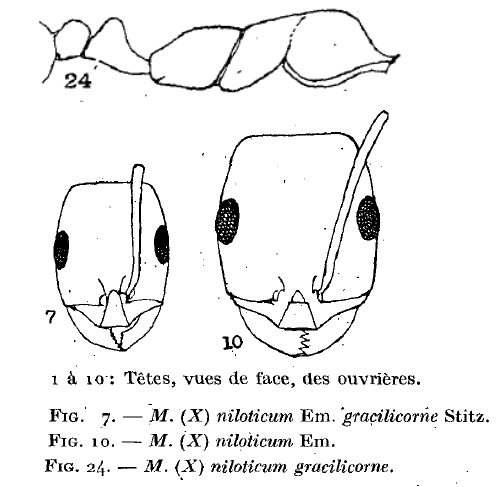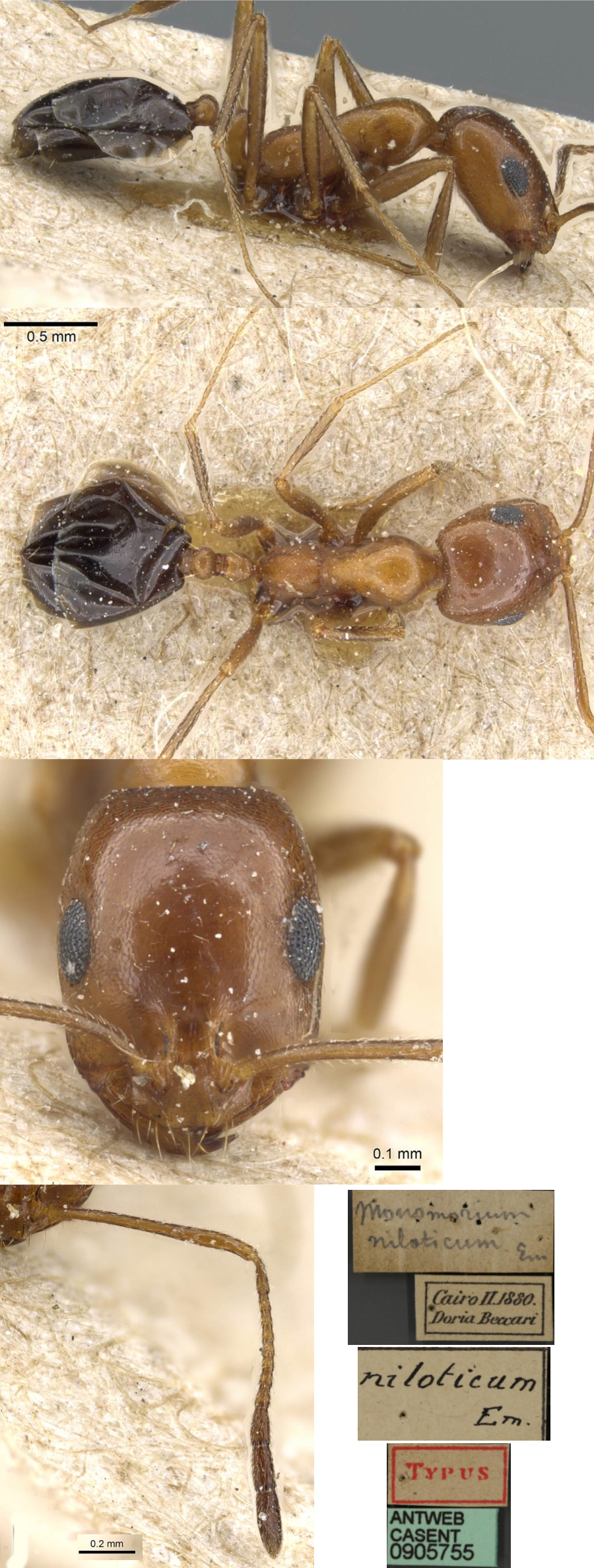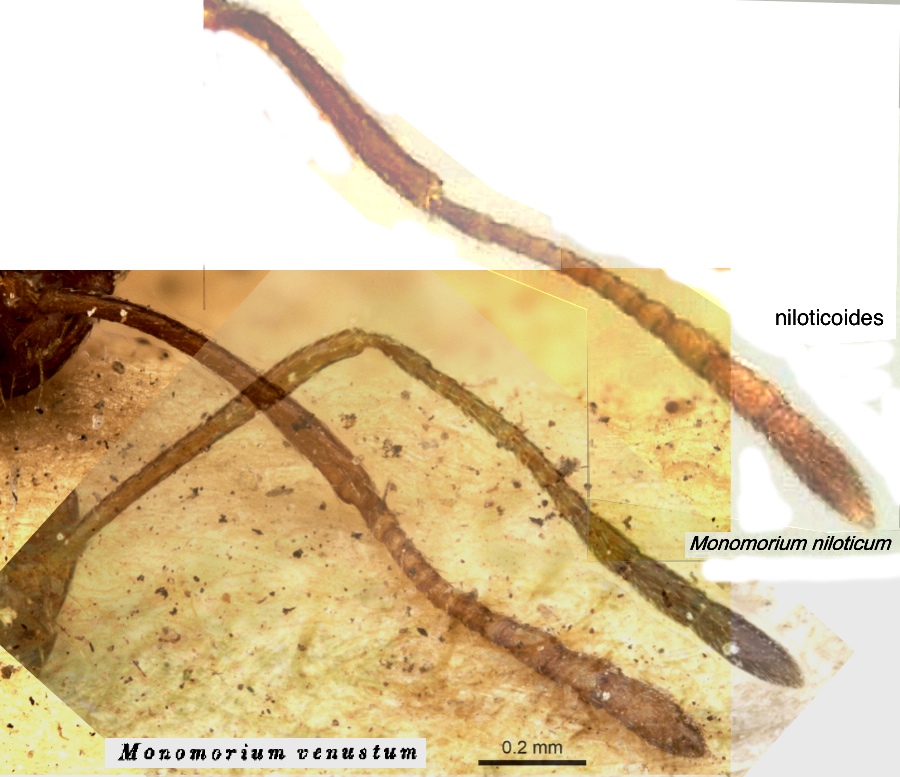Monomorium niloticum Emery
  Type location Egypt
(Monomorium niloticum n. sp.,
Emery, 1881b: 533, worker; see Santschi,1936a: 37) - see below Type location Egypt
(Monomorium niloticum n. sp.,
Emery, 1881b: 533, worker; see Santschi,1936a: 37) - see below
subspecies
gracilicorne
(Monomorium niloticum Em. r. gracilicorne n. stirps, Stitz,
1917: 346, worker) from Algeria - see http://www.antweb.org/specimenImages.do?code=casent0913820
niloticoides
(Monomorium venustum Smith v. niloticoides n. var.,
Forel, 1910a: 6,
worker; stirps of niloticum Santschi, 1936a: 37) from Israel,
Jerusalem - no images on Antweb (February 2015).
|
Emery's (1881b) description is at  . Stitz's
(1917) description of gracilicorne is at . Stitz's
(1917) description of gracilicorne is at  . Santschi's
(1936a) notes are at . Santschi's
(1936a) notes are at  . .
|
 Wheeler & Mann (1916:
170) listed "19. Monomorium venustum
F Smith subsp. niloticum
Emery, Wadi Gazelle (Wadi Ghazala), Sinai Peninsula". Wheeler & Mann (1916:
170) listed "19. Monomorium venustum
F Smith subsp. niloticum
Emery, Wadi Gazelle (Wadi Ghazala), Sinai Peninsula".
Santschi
(1936a) revived and separated the species as -
Scape surpasses occiput by more than twice its own width; all segments
of funiculus much longer than wide; club quite slender, the middle
segment more than twice as long as it is wide; alitrunk weakly pilose;
mostly yellow but at least gaster dull. His illustrations (right) have
no scale lines.
On niloticoides,
he stated the head and gaster shiny. From the photographs of
the types (below), the shiny form is the type species and niloticoides has a dull head
His key couplet gave At least the gaster dull. Nile
Valley (fig. 10) sp. niloticum
Em. Sahara and Algeria (fig. 7, 24) stirps gracilicorne Stitz
Forel (1910a) noted on niloticoides
- head as niloticum but the antennae and preapical segment of
funiculus are as venustum (see photograph of a cotype at the
bottom of this page); metanotal groove intermediate, pedicel also,
Jerusalem (Schmitz); he
regarded niloticum as a subspecies of venustum. His
statement on the antennae is not borne out by the photographs of the
type collections, see my compilation, below.
Stitz's (1917) description of gracilicorne
has the head brown, allitrunk and legs red brown and all parts of the body
matt.
|
 The
photomontage is of the type worker collated
from http://www.antweb.org/specimen.do?name=casent0905755 The
photomontage is of the type worker collated
from http://www.antweb.org/specimen.do?name=casent0905755
TL ca 3.3 mm HL 0.83 HW 0.63 EL 0.20 SL 0.82 PW 0.39 CI
79 SI 130 EI 32
|
Collingwood
(1985) distinguished it by - penultimate funiculus segment more than
twice as long as broad, head relatively long, widening anteriorly (CI
75-81); head finely sculptured, unicolorous red with alitrunk,
propodeum with flattened or incavate median area; metanotal groove deep
(in profile a right angle); antennal scape surpassing occiput; ultimate
funiculus segment shorter than combined length of preceding two
segments. He noted - one of the larger Monomorium similar to M.
venustum but generally of a brighter colour and with both head and
antennal segments more elongate.
Globally in salomonis-group with species such as bicolor
and pharaonis (Bolton, 1987). Known from Egypt and Saudi Arabia.
|
 The
photomontage collates the antennae of niloticoides,
niloticum and venustum (from
the syntype worker at casent0902221) The
photomontage collates the antennae of niloticoides,
niloticum and venustum (from
the syntype worker at casent0902221)
|
Oxford University Museum
specimens
Monomorium niloticum
B Taylor det.
|
Egypt
M James
2002
|
iii.2002
Sinai
28°33' N
33°56' E
|
St Katherine
protectorate
around the town of St Katherine, in mountains above 1500m |
1
|
 |
Monomorium niloticum
B Taylor det. |
Egypt
A Shepherd
mid striga
|
2010
Sinai
28°33' N
33°56' E
|
St Katherine
protectorate
around the town of St Katherine, in mountains above 1500m
|
2
|
 |
Monomorium niloticum
B Taylor det. |
Egypt
A Shepherd
Alcohol E
|
2010
Sinai
28°33' N
33°56' E
|
St Katherine
protectorate
around the town of St Katherine, in mountains above 1500m
|
2
|
 |
|
 Photomontage of a
worker from Egypt, Sinai, M James Photomontage of a
worker from Egypt, Sinai, M James
TL ca 2.8 mm HL 0.80 HW 0.56 EL 0.17 SL 0.80 PW 0.38 CI
73 SI 128 EI 25
|
 The
photomontage is of specimens from Egypt, Sinai;
collector Amy Shepherd (Alcohol E). The
photomontage is of specimens from Egypt, Sinai;
collector Amy Shepherd (Alcohol E).
|
 The photomontage is of specimens from Egypt, Sinai;
collector Amy Shepherd (mid Striga). The photomontage is of specimens from Egypt, Sinai;
collector Amy Shepherd (mid Striga).
|
 The
photomontage is of specimens from Jordan, Wadi Rum; A Lenoir (Lenoir
150c). The
photomontage is of specimens from Jordan, Wadi Rum; A Lenoir (Lenoir
150c).
|
|